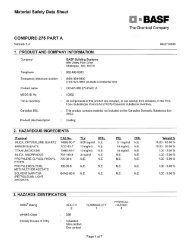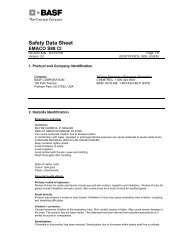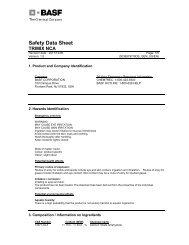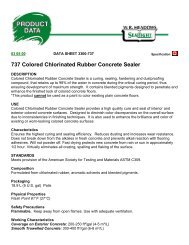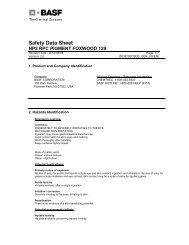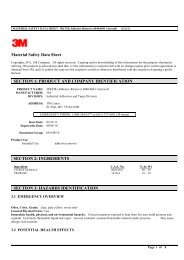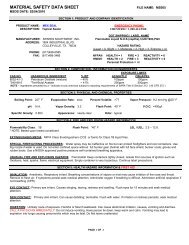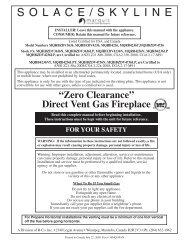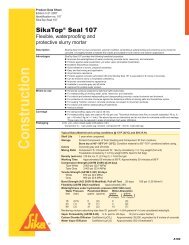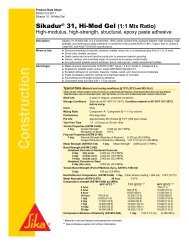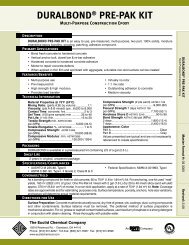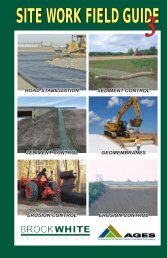Panel ErectionInformationPanel ErectionInformationRigging and the CraneGeneralThe most important phase during the construction of a tilt-upbuilding is the erection of the wall panels. It is extremelyimportant for the designers and contractors to plan and replanthis portion of the job. They should direct their efforts toensure that this important phase of construction is performedsafely and efficiently.Prior to ConstructionPrior to the actual start of construction, an inspection of thesite should be made by the contractor. The location of thejobsite may be such that special permits will be requiredto gain access to the site for heavy equipment such as thecrane. As an example, permits are a common requirementfor schools and church projects. These projects are usuallybuilt in residential areas where weight and size restrictionsmay exist.It is advisable for the contractor to investigate restrictions onearly daily start-up times. Many areas have noise abatementand dust control regulations. Also, the panel contractor anderection contractor should walk the site and determine a suitablelocation for the crane assembly and rigging make-up.Some local governments will not allow this activity on publicstreets.It is also advisable that any problems with uneven terrain benoted at this time and dealt with prior to bringing the craneonto the jobsite.The panel contractor and the erection contractor shouldalways agree on a location for both the crane entrance ontothe floor slab as well as the exit ramp off the floor slab. Ifnecessary, plans should be made to thicken the floor slabat these ramp locations so the crane weight will not damagethe edge of the slab.Since there must be a close, cooperative relationship betweenthe panel contractor and the erection subcontractor, itis advisable to select an erection sub-contractor during theearly days of the project. The erection sub-contractor andcrew should be well experienced in tilt-up, as panel tiltingand handling is a very specialized skill.sary to shut off the power in some overhead wires in orderto safely operate the crane during panel erection. Mostsafety regulations dictate that cranes will not be allowed towork closer than ten feet to power lines.The quality of the floor slab on a tilt-up project cannot beover emphasized due to the heavy weights that the slab willbe expected to support early in its life. Equally as importantas the slab, is the sub-base under the floor slab. When itcomes to supporting the combined weight of the crane andtilted panel, the floor slab is no better than its sub-base.Even a thick, properly engineered floor slab with two curtainsof reinforcing steel will not support the weight of the crane ifthe sub-base is unstable.To insure an efficient construction procedure, careful considerationmust be given to the casting location of the panels.The following two important criteria must be met if the contractorexpects to have a successful project:• Panels must be located for efficient CASTING.• Panels must be located for efficient LIFTING.The panel contractor should work with the erection subcontractorin developing the panel casting layout. The erector’sadvice should be sought so that the panels are cast in sucha position that a properly sized crane can safely reach anderect them.Underground tunnels, trenches and sewer lines are a verycommon occurrence and can create problems. It is necessaryto know the location of these underground hazardsand to avoid those that may need strengthening in order tosupport the crane’s weight. We have often found that thelocation of these underground hazards is not always notedon the architect/engineer’s plans. Further investigation bythe panel contractor should be made in an effort to discoverthese types of unknown hazards.Overhead electric or telephone wires can be a commonproblem on both urban and rural job sites. It may be neces-Crane CertificationThe crane that is finally selected for the project should beproperly certified. Many, if not all states have standardswith which erection sub-contractors must comply. Prudentcontractors make certain they have available at the jobsitePrior to ErectionSite InspectionAfter the panels are cast and curing, the panel contractor,erection sub-contractor, and the accessory supplier shouldagain walk the site. The terrain upon which the crane willtravel should be inspected and any further corrections noted.Crane selection should not be looked on as merely routine.General rules for sizing the crane state that the cranecapacity should be a minimum of two to three times that ofthe heaviest panel including the weight of the rigging gear.However, in the final analysis not only the panel weight, butalso the crane’s position relative to the panel must be considered:The following questions must be answered before finaldetermination of crane size can be established:• How far must the crane reach to lift the panel?• How far will the crane have to travel with the panel?• How far will the crane have to reach to set the panel?documentation attesting to the crane’s certification. The contractorshould also obtain a certificate of liability insurancefrom the erection sub-contractor.Corrective actions shall be taken prior to erection of thepanels.Entrance and exit ramps should be checked. The entranceramp should be built up so the crane descends slightly down20 02-09
Panel ErectionInformationonto the slab instead of crawling up onto it. The exit rampshould be built in the same manner. On some buildings,architectural openings are large enough for the crane to exit.In any case, do not let the crane’s weight bear at the extremeedge of the slab. This is of particular importance if the craneis walking out with the added weight of the closure panel.Equipment and CrewThe panel contractor and the erection contractor mustitemize the rigging and equipment that will be needed for aproper and safe lift. The instruction manual that is suppliedby Dayton Superior will specify all the types of rigging configurationand cable lengths for the project. These detailsshould be rigidly adhered to, since they are an integral partof the erection stress calculations.DAYTON S<strong>UP</strong>ERIOR DOES NOT SPECIFY THEDIAMETER OR SAFE WORKING LOAD OF THE CABLEas this is the responsibility of the erection contractor. Thepanel contractor should also make a list of required tools.The list should include, but not be limited to, a compressor,drills, wrenches, a bolt-on lift plate along with extra T-13 postdrilled anchors, ladders and miscellaneous hand tools. Aminimum of two extra lifting hardware units should be on thejob.It is also prudent to anticipate material needs for last minuterepairs. If a delay is caused for any reason, down time canadd up rapidly.The panel contractor should provide a clean working areawith all obstacles removed. Members of the erection crew willbe guiding a panel while it is being moved from the castinglocation to its position in the structure. Most of the time thesecrew members will be looking up at the rigging and inserts.They should not be tripping over loose debris and tools.The erection contractor’s minimum crew should consist ofthe crane operator, oiler (driver), rigger foreman, and twojourneyman riggers. This crew should be augmented, asrequired, by carpenters and laborers from the panel contractor’swork force, primarily to handle braces. In areas ofthe country where no erection contractors are available,the minimum crew should consist of crane operator, oiler,foreman and four to five laborers. An exception to this wouldbe with stacked panels which require an additional two tothree laborers. Consideration should also be given to havinga welder standing by. A properly staffed and well coordinatederection crew is the key to successful lifting.The crane operator must be a skilled journeyman, experiencedin handling tilt-up panels. He must be able to controlthree motions of his crane: hoist, swing and boom hoist. Itis quite normal to use all three of these functions simultaneously.Panel ErectionInformationPanel PreparationAll standing water should be blown away from around theperimeter of the panel. Also, remove all water that might bepooled in panel openings. Standing water prevents air fromentering under the panel and creates an additional loadthat must be overcome. These suction loads can be of suchstrength, that the additional load causes the lifting inserts tobe overloaded.Panel preparations should also include checking the insertsfor proper location, as shown in the erection instructions.It also includes removing the void former from the insert.All inserts should be checked with a lift hardware to makecertain that the hardware can be properly attached to thelifting insert. Strongbacks should also be properly installed atthis time.Day of Erection - Safety MeetingA safety meeting with full crew should be held beforeany lifting starts and the accessory supplier should also bepresent for this meeting. Personnel should be told to neverplace themselves under the panel while it is being tilted or onthe blind side of the panel when the crane is traveling with it.The crew should be told to never get between the crane andthe panel. A conscientious erection contractor will alwaysadvise his crew that horseplay or unnecessary talking will notbe allowed.A standard part of the safety meeting, which is normallyconducted by the rigger foreman, should contain commentsabout the need to remain alert. Each person’s safetydepends on the safe practices of others. The crew shouldbe reminded that safety is everyone’s responsibility andthat hard hats are required. It is advisable for the erectioncontractor to create a safety check list and have the crewmembers sign it at the end of the safety meeting.The rigger foreman should be clearly identified at thesafety meeting. This individual will be the one the crane02-09The required compression strength of the concrete mustbe attained. The strength of concrete, noted in the erectioninstructions, refers to the concrete compressive strength atthe time of lifting and not the ultimate or 28 day strength .This should be checked by an independent test lab usingbeam or cylinder tests.Blockouts over interior footings should not be broken outprior to the lift, particularly in rainy weather. Water under theslab could make the subgrade weak. Projecting ledgers andreinforcing steel must be brought to the attention of all concerned.All bracing that is attached to the panel prior to the liftmust be inspected for proper length and type.operator will be looking to for all signals. The rigger foremanmust be experienced with handling panels and be totallyfamiliar with the precise set of hand and arm signals. This willsafely communicate his desires to the crane operator. Verbalinstructions are all but impossible due to the noise level in theoperator’s cab.A competent rigger foreman will create and maintain a confidentatmosphere during the lift. He will always remain alertto guard against overconfidence, and will not allow the crewto become careless.During the safety meeting the rigger foreman should demonstratethe proper use of the lifting hardware, bracing hardwareand the proper way to hold a brace and how to use anynecessary tools and equipment. If the crane is using rollingoutriggers a warning to the crew to stay clear is in order.The crew should be broken up into teams for handlingbracing, rigging, and hardware attachment. Each individual’sfunction and responsibility should be clearly defined.The panel contractor should furnish an individual whose21



